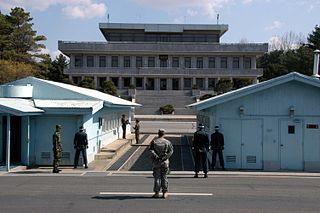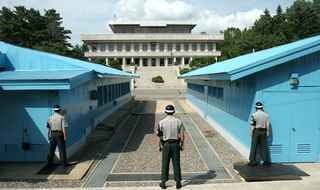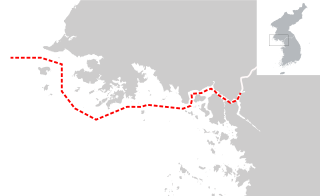| |||||
| Centuries: | |||||
|---|---|---|---|---|---|
| Decades: | |||||
| See also: | Other events of 1997 Years in North Korea Timeline of Korean history 1997 in South Korea | ||||
Events from the year 1997 in North Korea .
| |||||
| Centuries: | |||||
|---|---|---|---|---|---|
| Decades: | |||||
| See also: | Other events of 1997 Years in North Korea Timeline of Korean history 1997 in South Korea | ||||
Events from the year 1997 in North Korea .
1995~1999:Arduous March

The Korean War was fought between North Korea and South Korea from 1950 to 1953. The war began on 25 June 1950 when North Korea invaded South Korea following clashes along the border and rebellions in South Korea. North Korea was supported by China and the Soviet Union while South Korea was supported by the United States and allied countries. The fighting ended with an armistice on 27 July 1953.


The 24th Infantry Division was an infantry division of the United States Army that was inactivated in October 1996. Formed during World War II from the disbanding Hawaiian Division, the division saw action throughout the Pacific theater, first fighting in New Guinea before landing on the Philippine islands of Leyte and Luzon, driving Japanese forces from them. Following the end of the war, the division participated in occupation duties in Japan, and was the first division to respond at the outbreak of the Korean War. For the first 18 months of the war, the division was heavily engaged on the front lines with North Korean and Chinese forces, suffering over 10,000 casualties. It was withdrawn from the front lines to the reserve force for the remainder of the war after the second battle for Wonju, but returned to Korea for patrol duty at the end of major combat operations.

The Military Demarcation Line (MDL), sometimes referred to as the Armistice Line, is the land border or demarcation line between North Korea and South Korea. On either side of the line is the Korean Demilitarized Zone (DMZ). The MDL and DMZ were established by the Armistice.

The Joint Security Area is the only portion of the Korean Demilitarized Zone (DMZ) where North and South Korean forces stand face-to-face. The JSA is used by the two Koreas for diplomatic engagements and, until March 1991, was also the site of military negotiations between North Korea and the United Nations Command (UNC).

United States Forces Korea (USFK) is a sub-unified command of U.S. Indo-Pacific Command (USINDOPACOM). USFK is the joint headquarters for U.S. combat-ready fighting forces and components under the ROK/US Combined Forces Command (CFC) – a supreme command for all of the South Korean and U.S. ground, air, sea and special operations component commands. Major USFK elements include U.S. Eighth Army (EUSA), U.S. Air Forces Korea, U.S. Naval Forces Korea (CNFK), U.S. Marine Forces Korea (MARFORK) and U.S. Special Operations Command Korea (SOCKOR). It was established on July 1, 1957.

The Northern Limit Line or North Limit Line (NLL) – 북방한계선 – is a disputed maritime demarcation line in the Yellow (West) Sea between the Democratic People's Republic of Korea (DPRK) in the north, and the Republic of Korea (ROK) in the south. This line of military control acts as the de facto maritime boundary between North and South Korea.

The Battle of Yeonpyeong took place between the navies of the Democratic People's Republic of Korea and the Republic of Korea on 15 June 1999, off the island of Yeonpyeong.

The Battle of Yeongpyeong was a confrontation at sea between North Korean and South Korean patrol boats along a disputed maritime boundary near Yeonpyeong Island in the Yellow Sea in 2002. This followed a similar confrontation in 1999. Two North Korean patrol boats crossed the contested border and engaged two South Korean Chamsuri-class patrol boats. The North Koreans withdrew before South Korean reinforcements arrived.

Australia entered the Korean War on 28 September 1950, following the invasion of South Korea by North Korea. The war's origins began after Japan's defeat in World War II, which heralded the end to 35 years of Japanese occupation of the Korean Peninsula. The surrender of Japan to the Allied forces on 2 September 1945, led to the division of Korea into two countries, which were officially called the Democratic People's Republic of Korea (DPRK) and the Republic of Korea (ROK), with the DPRK being occupied by the Soviet Union, and the ROK, below the 38th Parallel, being occupied by the United States (US).

The Pohang-class PCC is the low-end complement of the high-low mix domestic naval construction plan of the Republic of Korea Navy under the 1st Yulgok Project (1974-1986) for the Republic of Korea Armed Forces. It was originally planned as a Batch II production of Donghae-class corvette, but many changes on overall design, notably applying the hull design of Ulsan-class frigate, reclassified the ship to its own class. The ship is designed for patrolling maritime border, including the Northern Limit Line, protecting the littoral zone, and combating the North Korean vessels.
The 1998 Yeosu submersible incident was a naval skirmish that occurred off of the southern coast of South Korea between 17 and 18 December 1998. On the evening of 17 December, a South Korean observation post sighted a North Korean semi-submersible naval vessel in the vicinity of the city of Yeosu. The semi-submersible was discovered and sunk during a subsequent search and skirmish on the morning of 18 December.

The Daecheong incident, also known as the Battle of Daecheong, was a skirmish between the South Korean and North Korean navies near the Northern Limit Line (NLL) on 10 November 2009 off Daecheong Island. The incident began at 11:27 am when a North Korean navy patrol boat crossed the NLL, which is not recognized by North Korea (DPRK). After two verbal warnings from South Korean naval units, one of the South Korean patrol boats fired a warning shot. In response, the North Korean boat began firing at the South Korean ship. A patrol boat from the DPRK was seriously damaged, with eight casualties while the navy of South Korea (ROK) sustained no casualties.

The Battle of Taejon was an early battle of the Korean War, between U.S. and North Korean forces. Forces of the United States Army attempted to defend the headquarters of the 24th Infantry Division. The 24th Infantry Division was overwhelmed by numerically superior forces of the Korean People's Army (KPA) at the major city and transportation hub of Taejon. The 24th Infantry Division's regiments were already exhausted from the previous two weeks of delaying actions to stem the advance of the KPA.
The Chaplain–Medic massacre took place in the Korean War on July 16, 1950, on a mountain above the village of Tuman, South Korea. Thirty unarmed, critically wounded United States Army (US) soldiers and an unarmed chaplain were murdered by members of the Korean People's Army (KPA) during the Battle of Taejon.
Events from the year 1996 in North Korea.

South Korean defectors are South Korean citizens who have defected to North Korea. After the Korean War, 333 South Korean prisoners of war detained in North Korea chose to stay in the country. During subsequent decades of the Cold War, some people of South Korean origin defected to North Korea as well. They include Roy Chung, a former U.S. Army soldier who defected to North Korea through East Germany in 1979. Aside from defection, North Korea has been accused of abduction in the disappearances of some South Koreans.